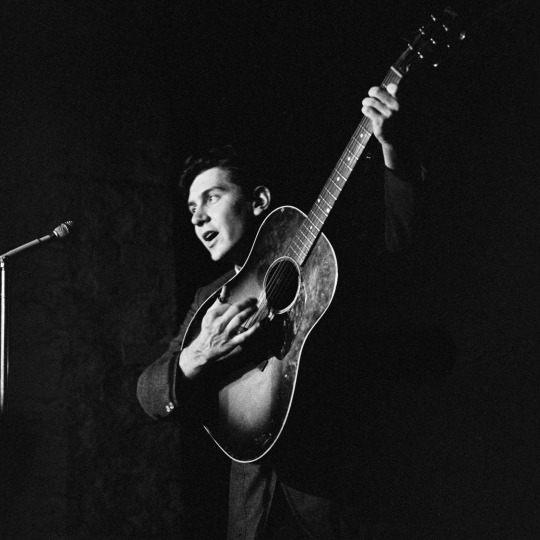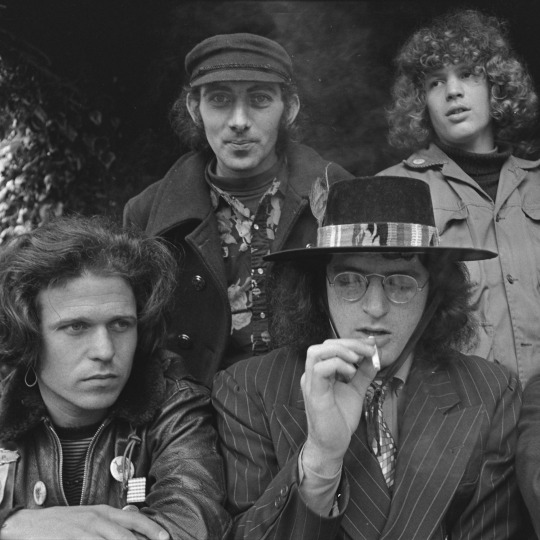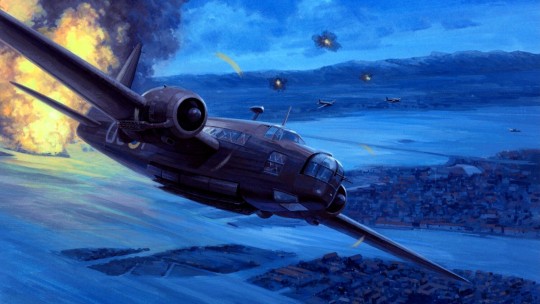#september 21 1942
Explore tagged Tumblr posts
Text
Una formación de seis policías judíos en el gueto de Varsovia, julio de 1942
🇪🇸 La policía judía del gueto de Varsovia fue creada al mismo tiempo que el gueto y estaba compuesta por jóvenes bien educados, principalmente abogados y personas de clase alta. Al comienzo, la policía se encargaba del tráfico, la limpieza y el orden en el gueto, pero en 1941 tuvo que suministrar trabajadores forzados a las autoridades alemanas. En julio de 1942, cuando comenzaron las deportaciones masivas de judíos de Varsovia a Treblinka, la policía judía recibió la orden de reunir a los judíos para estas deportaciones. A los policías judíos se les prometió inmunidad para ellos y sus familias, y algunos creyeron que al cumplir con estas órdenes, estaban ayudando a salvar vidas judías. Sin embargo, al participar en las redadas, se convirtieron en el grupo más odiado dentro del gueto. A medida que las deportaciones continuaban, los policías judíos se dieron cuenta de que su propio destino también era incierto y empezaron a desertar, buscar empleo en los talleres del gueto o esconderse. En respuesta, los alemanes aplicaron medidas más duras, amenazando con arrestar a sus familias si no cumplían con la cuota diaria de deportados. El 21 de septiembre de 1942, durante Yom Kipur, la mayoría de la policía judía y sus familias fueron deportados a Treblinka, terminando así las deportaciones masivas en Varsovia.

🇺🇸 The Jewish police of the Warsaw ghetto were established simultaneously with the ghetto itself and were comprised of well-educated young people, mostly lawyers and individuals from the upper class. Initially, the police were responsible for traffic control, sanitation, and maintaining order within the ghetto, but in 1941, they were tasked with providing forced laborers to the German authorities. In July 1942, when the mass deportations of Jews from Warsaw to Treblinka began, the Jewish police were ordered to gather Jews for these deportations. The Jewish police were promised immunity for themselves and their families, and some believed that by following orders, they were helping to save Jewish lives. However, their participation in the raids made them the most hated group within the ghetto. As the deportations continued, the Jewish police realized that their own fate was uncertain, and they began to desert, seek employment in the ghetto's workshops, or go into hiding. In response, the Germans took harsher measures, threatening to arrest their families if they didn't meet the daily deportation quota. On September 21, 1942, during Yom Kippur, the majority of the Jewish police and their families were deported to Treblinka, marking the end of the mass deportations in Warsaw.
#treblinka#policía judía#judaism#judaísmo#judío#jewish#jewish history#historia judía#segunda guerra mundial#world war 2#world war ii#ghetto#warsaw ghetto#deportation#immunity#mass deportations#september 21 1942#1942#yom kippur#varsovia#gueto de varsovia
2 notes
·
View notes
Text




21 September 1942. First flight of the B-29 Superfortress XB-29-BO, 41-002, first of three prototypes. American four-engine heavy bomber. It reached 6,000 feet before testing the stability/control, control power/response and stall characteristics. The flight took 1 hr. 15 min.
@ron_eisele via X
254 notes
·
View notes
Text















Jewish musicians of the 1960s
✡︎ Bob Dylan (born Robert Allen Zimmerman; May 24, 1941)
✡︎ Lesley Gore (born Lesley Sue Goldstein; May 2, 1946 – February 16, 2015)
✡︎ Leonard Cohen (September 21, 1934 – November 7, 2016)
✡︎ Barbra Streisand (born April 24, 1942)
✡︎ Marty Balin (born Martyn Jerel Buchwald; January 30, 1942 – September 27, 2018) and Jorma Kaukonen (born December 23, 1940) of Jefferson Airplane
✡︎ Robby Krieger (born January 8, 1946) of The Doors
✡︎ Paul Simon (born October 13, 1941) and Art Garfunkel (born November 5, 1941) of Simon & Garfunkel
✡︎ Phil Ochs (December 19, 1940 – April 9, 1976)
✡︎ Cass Elliot (born Ellen Naomi Cohen; September 19, 1941 – July 29, 1974) of The Mamas & The Papas
✡︎ Mary (December 28, 1948 – January 19, 2024) and Elizabeth Weiss (born November 27, 1946) of The Shangri-Las
✡︎ Neil Diamond (born January 24, 1941)
✡︎ Janis Ian (born Janis Eddy Fink; April 7, 1951)
✡︎ Robbie Robertson (born Jaime Royal Robertson; July 5, 1943 – August 9, 2023) of The Band
✡︎ Gary Hirsh (March 9, 1940 – August 17, 2021), Barry Melton (born June 14, 1947), Joseph Allen "Country Joe" McDonald (born January 1, 1942), and David Cohen (born August 4, 1942) of Country Joe and the Fish
✡︎ Manfred Mann (born Manfred Sepse Lubowitz; October 21, 1940)
#1960s#mine#music#jewish#bob dylan#lesley gore#leonard cohen#barbra streisand#marty balin#jorma kaukonen#jefferson airplane#robby krieger#the doors#paul simon#art garfunkel#simon and garfunkel#simon & garfunkel#phil ochs#cass elliot#the mamas and the papas#the shangri las#neil diamond#janis ian#robbie robertson#manfred mann#country joe and the fish
156 notes
·
View notes
Photo

Boeing B-29 Superfortress
The Boeing B-29 Superfortress was a four-engined, long-range bomber of the United States Air Force. The largest of all Second World War (1939-45) bombers, B-29s were used to strike Japanese targets from the summer of 1944. In August 1945, the B-29s 'Enola Gay' and 'Bockscar' each dropped an atomic bomb on Hiroshima and Nagasaki, respectively, thereby ending the war.
Development
In the 1930s, the United States Army Air Corps (USAAC) required a long-range strategic bomber that could attack enemy targets thousands of miles from the aircraft's home base. One of the problems to make such an aircraft a reality was to find engines which were powerful enough for the task. The project to design and build a long-range, high-altitude precision bomber, or VLR (Very Long Range) as such aircraft became known, was greatly accelerated following the invasion of Poland in 1939 by Nazi Germany and the outbreak of WWII. In January 1940, five aircraft companies were tasked with designing a VLR bomber. Four companies came back with a design proposal: Consolidated, Douglas, Lockhead, and Boeing. After two of the companies later withdrew, only Consolidated and Boeing won construction contracts in September 1940. Ultimately, each company built three prototypes. Boeing's construction plans were more advanced since it had already been working on modifications of its existing Boeing B-17 Flying Fortress design. Boeing received an order of 1,500 VLRs and promised these aircraft would be ready within three years.
Following the Japanese attack on Pearl Harbour in Hawaii, home of the US Pacific naval fleet, on 7 December 1941, the need for VLRs in the vast theatre of the Pacific Ocean suddenly became a necessity. The first Boing VLR prototype, called XB-29, flew on 21 September 1942. The very large wings of the craft were designed to help it land at lower speeds, and tricycle landing gears helped bear the tremendous weight. 14 test aircraft began to fly from June 1943. The planes were built at four principal plants: Renton, Wichita, Marietta, and Omaha. Boeing, Bell, and Martin were just three of the main companies involved, but there were thousands of others providing components and partial assembly. The B-29 project "was the largest aircraft manufacturing project undertaken in the USA during World War II" (Mondey, 29). It was also the most expensive. From the autumn of 1943, the first B-29 bombers were delivered to US air bases.
B-29 Superfortress in Flight
US Air Force (Public Domain)
Continue reading...
48 notes
·
View notes
Text
I’ve been doing some research into WWII for a while now, and considering Tom Riddle grew up during that time I thought I’d detail what his life during the summers was probably like at the orphanage.
(Note that it’s hard to find information, so some of this is more guessing and not fully backed.)
There were two blitzes, the first one being from September 7, 1940 to May 11, 1941 while the baby blitz was from January 21 to May 29 in 1944 (he would be an adult by that summer so I guess it’s not relevant). This means that Tom wasn’t in London during the blitz, but he was there for the aftermath.
This means that when Tom returned from Hogwarts in 1941 it was likely he had to aid in the clearing of rubble. At this time he was fourteen which means that he was most likely working a full time job which wasn’t uncommon at the time for 14-17 y/o’s. This means that Tom either spent most of his summer either clearing rubble or was working in major industries at the time (engineering, aircraft production, shipbuilding, etc…).
I think this is very likely considering he was living in an orphanage and at this time many orphanages in London were operating in over capacity. It is extremely likely the older kids were forced to work to make some income no matter how little and support themselves. The youngest were probably sent to the countryside before the blitz to be kept safe, but I highly doubt the orphanage would have the resources to completely relocate and they were still needed in London.
This means Tom was working full time every summer from the age of 14 to 16/17 (completely dependent on when he left). When he was sixteen Tom could have participated in the Civil Defence and from what I’ve read some form of national service was required at this age. This means Tom could have very well been participating in Civil Defence or something similar.
Nightly during 1941 and 1942 the air raid sirens would go off and people would have to go to the closest tube of air raid shelter so that is likely where most nights were spent. These places were often extremely crowded as well, people basically laying shoulder to shoulder. For someone like Tom I assume this meant getting no sleep whatsoever.
I couldn’t find information on bombs being dropped outside of the blitzes, but I do think it was possible. So, Tom may have lived through a few bombings, but not to the extent of what happened during the blitzes.
Rationing was a large thing at this time and considering Tom was older at this time he would not get as much aid. There is a high probability that he wasn’t eating enough for what he was doing. Including food clothes were rationed significantly and Tom would be at the peak of his growth at this time and considering how tall he is getting fitting clothes would have been extremely difficult. Though minors were given more clothing coupons at this time due to growth.
Rationing also brought the need for people to grow their own food, so Tom and the other children would most likely be responsible for growing and harvesting food.
Now, this goes into theory territory.
I do believe there is a high chance Tom was kicked out of the orphanage for large amounts of time during the summers due to him being old enough to work and little space and resources. This means he was probably homeless a couple times over the summer, and possibly he was for several summers altogether. He also wasn’t liked at Wool’s so this makes it even more likely.
If anyone wants me to go more into detail on any of these points please send me an ask because I would love to.
#tom riddle#tom marvolo riddle#hp#wwii era#1941#1942#muggle london#tom riddle headcanon#kind of#it’s historically based i guess#tom riddle and wwii#hp headcanon#hp thoughts#hp meta#tom riddle theory
30 notes
·
View notes
Text

Gasoline rationing during wartime meant that one-third of New York’s 11,700 taxicabs ceased operations on September 21, 1942, under an order of the Office of Defense Transportation. They were stored in a parking lot with their tires removed and their bodies covered with protective grease.
Photo: Associated Press
#vintage New York#1940s#World War II#home front#gas rationing#rationing#wartime rationing#taxis#September 21#21 September#21 Sept.#Sept. 21
168 notes
·
View notes
Text

1941 01 13 Wellington over Venice - Graham Turner
Wellingtons over Venice, 12/13 January 1941 Eyewitness accounts that describe Bomber Command's operations to Italy often speak of the long duration (some 9 hours) of the trip, and a boredom that was only punctuated by the joy in seeing the snow-covered Alpine peaks and the short-lived drama of bombing the target. Yet the earlier attacks on Italy, in 1940 and 1941, often proved to be much more wild adventures. Individual aircraft selected their own way of getting to the target and, once there, they would not just drop their bomb load but often engaged in 'further activities', such as the low-level shooting-up of flak positions, airfields, road convoys, moving trains or - in this case - ocean liners. In early December 1940, 4 Group had been taken off Italian operations owing to the need to conserve its Whitley Mk Vs for large fire-raising operations against German cities, and the 'Italy assignment' was transferred to 3 Group, which operated the Vickers Wellington MxIc.
The operational instructions issued by HQ Bomber Command stated they were to attack Italian targets, but only with a maximum number of 15 aircraft; they were given a fixed list of German targets from which to choose alternatives if weather precluded attack upon Italian objectives, but clearly the latter was the priority.
On 4 December, 3 Group undertook its first Italian operation, when 15 aircraft were detailed to bomb the Royal Arsenal in Turin, and Wellingtons were also sent to italy on 18 and 21 December, and on 11/12 January 1941. The following night, seven Wellingtons were ordered to attack the oil refineries at Porto Marghera, near Venice, and the progress of this operation is depicted in this battle scene. The bombers scored direct hits on the target area: one 1, 000lb boob dropped from 700ft scored a direct hit on large buildings at the oil refinery, causing a massive explosion with reddish/white smoke and flames to 400ft, whilst further bombs caused oil storage tanks to explode and a large building to collapse and disintegrate. Fifteen minutes into the attack, the target area was described by aircrews as being a mass of flames. Yet 3 Group's aircraft had not travelled that far (a round trip of 1,500 miles) just to drop their modest bomb loads (at that range about 1,500lb).
With little chance of being intercepted - in early 1941 the Regia Aeronautica had yet to train for the night-fighter role - the Wellingtons used their machine guns to strafe the oil refinery and flak positions. Two aircraft got down very low - to about 300ft and 390ft respectively - to attack the Italian liners Rex and Conte di Savoia, which were being used as troop ships to North Africa. The raid report stated that another Wellington on its return journey attacked Padua aerodrome from an incredible 20ft. Such activity encapsulates the brave - if at times reckless - endeavour of the early bomber attacks on Italy. Operations did become a lot more organised, more controlled and, ultimately, more devastating from autumn 1942 onwards, though a final 'wild ride' would be the daylight operation to Milan by 5 Group's Lancasters on 24 October 1942, which culminated in some low-level flying and strafing by machine guns (...). As for the two Italian liners, the next time the Rex was attacked by the RAF, in conjunction with Beaufighters of the South African Air Force, was on 8 September
16 notes
·
View notes
Text

U-Roy *September 21, 1942
8 notes
·
View notes
Photo

Antonio-Bueno (with-Xavier-Bueno) - La-carrozza-passeggiata-alle-cascine-1942- self portrait
Antonio Bueno (21 July 1918 – 26 September 1984) was an Italian painter of Spanish origin.
117 notes
·
View notes
Text

Victoria Cross for Lancaster pilot Squadron Leader Ian Bazalgette – August 1944
Header main image: ‘Beyond Praise’ – Bazalgette’s blazing Lancaster ND811, ‘F2-T’, with only one engine still running, skims the village of Senantes, France, before crashing on 4th August 1944. (Artwork: Len Krenzler)
Eighty years ago this month, in August 1944, an incredible and selfless act of supreme gallantry by Lancaster Pathfinder pilot Squadron Leader Ian Willoughby “Baz” Bazalgette resulted in the subsequent award to him of a posthumous Victoria Cross (VC).
Ian Bazalgette was born in the Canadian city of Calgary in October 1918, to parents of English and Irish background. The family always called him “Will” and in 1927, when he was nine years old, they all moved back to England. When the Second World War began, he was almost 21 and having volunteered for military service he initially served with the Royal Artillery, being commissioned in 1940, before transferring to the RAF Volunteer Reserve. After completing his pilot training, he joined 115 Squadron at Mildenhall in September 1942, to fly the Vickers Wellington twin-engine bomber operationally. In the RAF his nickname became “Baz”.
When he had completed 13 operations flying Wellingtons, Bazalgette and his squadron transitioned to the four-engine Lancaster and he flew a further 15 ‘ops’ against heavily defended targets in Europe, surviving some harrowing experiences, including a crash landing. He was awarded the Distinguished Flying Cross (DFC), with the citation mentioning his “great courage and determination in the face of the enemy”. When his first operational tour was complete, he was posted as an instructor at No 20 Operational Training Unit, based at Lossiemouth in Scotland. Then in April 1944 he was ‘head hunted’ for the Pathfinder Force and joined 635 Squadron at RAF Downham Market, Norfolk, as a flight commander with promotion to acting squadron leader. He completed a number of Pathfinder target- marking operations in the lead-up to D-Day and afterwards.

A 635 Sqn Lancaster with the unit’s ‘F2’ code letters at Downham Market in 1944. This aircraft has the H2S radar dome under the rear fuselage and is fitted with the then secret ‘Village Inn’ radar-directed Airborne Gun Laying Turret (AGLT) equipment for the rear turret. Bazalgette flew Lancaster ED811 ‘F2-T’ on 4th August 1944.
On 4th August 1944, on his 58th operation, Bazalgette was the master bomber for a daylight raid against the V-1 flying-bomb storage caves at Trossy St Maxim, France. He was tasked with marking the target and controlling the Main Force bombing. Nearing the target his Lancaster, ND811 ‘F2-T’, came under heavy anti-aircraft fire; both starboard engines were put out of action and serious fires broke out in the starboard wing and the fuselage. As the deputy master bomber had already been shot down, with the deaths of all those on board, the success of the attack depended on Bazalgette. Knowing this, he pressed onto the target, despite the state of his Lancaster, and marked it accurately.

Sqn Ldr Ian Bazalgette DFC (far left) with his usual 635 Sqn crew (L to R): Geoff Goddard, Ivan Hibbert, Chuck Godfrey, Bob Hurnhall (who was replaced by Vernon Leeder on 4th August 1944), Douglas Cameron and George Turner.
After dropping his markers and bombs, Bazalgette’s crippled Lancaster dived almost out of control and bursts of ‘flak’ hit the nose of the aircraft badly injuring the bomb aimer, Flight Lieutenant Ivan Hibbert, whose right arm was almost torn off. The flight engineer, Sergeant George Turner, and the wireless operator, Flying Officer Charles “Chuck” Godfrey, dragged Hibbert from his position in the nose in a critical condition, carried him to the rest bunk, applied a tourniquet and injected him with morphine. The crew attempted to fight the flames inside the aircraft, but smoke filled the fuselage and the mid-upper gunner, Flight Sergeant Vernon Leeder RAAF, was overcome by fumes. Leeder was not part of Bazalgette’s usual crew, but had replaced Flight Sergeant Hurnhall for this sortie. Then the port inner engine failed and, with only one engine running, altitude could no longer be maintained. Bazalgette ordered those of his crew able to do so to abandon the aircraft, and four of them bailed out from low altitude. All four survived and subsequently evaded capture with the help of the French Resistance. Aware that his bomb aimer and the mid-upper gunner could not bail out and refusing to leave them, Bazalgette attempted to crash-land the burning Lancaster in a last effort to save them. He managed to put the aircraft down in a field near the small French village of Senantes, but moments later the Lancaster exploded and Bazalgette and his two comrades were killed.

Left: Sqn Ldr Ian “Baz” Bazalgette. Centre: Bazalgette’s medals. Right: The BBMF Lancaster flies in tribute to all who flew with Bomber Command during the Second World War and especially those who lost their lives. (Lancaster image: Lisa Harding).
In August 1945 Squadron Leader Ian W Bazalgette DFC was posthumously awarded the Victoria Cross for his heroic sacrifice in not abandoning his two wounded comrades who remained on board. The citation for his VC in the London Gazette included the words, “His heroic sacrifice marked the climax of a long career of operations against the enemy. He always chose the more dangerous and exacting roles. His courage and devotion to duty were beyond praise.”
LEST WE FORGET
@memorialflightclub.com
10 notes
·
View notes
Text










Alaska Highway, CDN (No. 3)
On September 24, 1942, crews from both directions met at Mile 588 at what became named Contact Creek, at the British Columbia-Yukon border at the 60th parallel; the entire route was completed October 28, 1942, with the northern linkup at Mile 1202, Beaver Creek, and the highway was dedicated on November 20, 1942, at Soldier's Summit.Replica log bridge at Aishihik River crossing
Although it was completed on October 28, 1942, and its completion was celebrated at Soldier's Summit on November 21 (and broadcast by radio, the exact outdoor temperature censored due to wartime concerns), the "highway" was not usable by general vehicles until 1943. Even then there were many steep grades, a poor surface, switchbacks to gain and descend hills, and few guardrails. Bridges, which progressed during 1942 from pontoon bridges to temporary log bridges, were replaced with steel bridges where necessary. A replica log bridge, the Canyon Creek bridge, can be seen at the Aishihik River crossing; the bridge was rebuilt in 1987 and refurbished in 2005 by the Yukon government where it functions as a popular tourist attraction. The easing of the Japanese invasion threat resulted in no more contracts being given to private contractors for upgrading of specific sections.
Some 100 miles (160 km) of route between Burwash Landing and Koidern, Yukon, became nearly impassable in May and June 1943 due to permafrost thawing under the road and destroying the layer of delicate vegetation that held the road together. A corduroy road was built to restore the route, and corduroy still underlies old sections of highway in the area. Modern construction methods do not allow the permafrost to thaw, either by building a gravel berm on top or replacing the vegetation and soil immediately with gravel. The Burwash-Koidern section, however, is still a problem as the new highway built there in the late 1990s continues to experience frost heave.
Pincers on Japan and Look to the North, both 1944 productions, were National Film Board of Canada documentaries that depicted the construction of the Alaska Highway.
Source: Wikipedia
#Watson Lake#Alaska Highway#street scene#travel#original photography#vacation#landmark#landscape#countryside#summer 2023#flora#nature#woods#forest#fireweed#wildflower#mountains#Canada#Yukon#bridge#Alaska-Canadian Highway#ALCAN Highway#Alaskan Highway#the North#no traffic#reflection#tourist attraction#Muncho Lake Provincial Park#British Columbia#caribou
17 notes
·
View notes
Photo

Boeing B-29 Superfortress
The Boeing B-29 Superfortress was a four-engined, long-range bomber of the United States Air Force. The largest of all Second World War (1939-45) bombers, B-29s were used to strike Japanese targets from the summer of 1944. In August 1945, the B-29s 'Enola Gay' and 'Bockscar' each dropped an atomic bomb on Hiroshima and Nagasaki, respectively, thereby ending the war.
Development
In the 1930s, the United States Army Air Corps (USAAC) required a long-range strategic bomber that could attack enemy targets thousands of miles from the aircraft's home base. One of the problems to make such an aircraft a reality was to find engines which were powerful enough for the task. The project to design and build a long-range, high-altitude precision bomber, or VLR (Very Long Range) as such aircraft became known, was greatly accelerated following the invasion of Poland in 1939 by Nazi Germany and the outbreak of WWII. In January 1940, five aircraft companies were tasked with designing a VLR bomber. Four companies came back with a design proposal: Consolidated, Douglas, Lockhead, and Boeing. After two of the companies later withdrew, only Consolidated and Boeing won construction contracts in September 1940. Ultimately, each company built three prototypes. Boeing's construction plans were more advanced since it had already been working on modifications of its existing Boeing B-17 Flying Fortress design. Boeing received an order of 1,500 VLRs and promised these aircraft would be ready within three years.
Following the Japanese attack on Pearl Harbour in Hawaii, home of the US Pacific naval fleet, on 7 December 1941, the need for VLRs in the vast theatre of the Pacific Ocean suddenly became a necessity. The first Boing VLR prototype, called XB-29, flew on 21 September 1942. The very large wings of the craft were designed to help it land at lower speeds, and tricycle landing gears helped bear the tremendous weight. 14 test aircraft began to fly from June 1943. The planes were built at four principal plants: Renton, Wichita, Marietta, and Omaha. Boeing, Bell, and Martin were just three of the main companies involved, but there were thousands of others providing components and partial assembly. The B-29 project "was the largest aircraft manufacturing project undertaken in the USA during World War II" (Mondey, 29). It was also the most expensive. From the autumn of 1943, the first B-29 bombers were delivered to US air bases.
Continue reading...
18 notes
·
View notes
Text

#VoxPop The long-running radio program Vox Pop often focused on the American railroad and railroad workers.
On September 21, 1942, the program highlighted the New York, New Haven, and Hartford Railroad in a broadcast from the Cedar Hill Yard in New Haven, Connecticut. Here, interviewee Benjamin T. Savory shows host Parks Johnson the controls of a steam locomotive. Savory joined the New Haven Railroad in 1903. He retired in 1949 after a 50-year career in railroading. He passed away in Manchester, Connecticut, in 1954 at the age of 73.
Source: Parks Johnson collection on Vox Pop
11 notes
·
View notes
Text
Fritz Katzmann, also known as Friedrich Katzmann, was a German SS and Police Leader during the nazi era. He perpetrated genocide in the cities of Kattowitz (today, Katowice), Radom, Lemberg (today, Lviv), Danzig (today, Gdańsk), and across the nazi occupied District of Galicia in the General Government during the Holocaust in Poland, making him a major figure during the Holocaust there.
Katzmann was responsible for many of the atrocities that were perpetrated by the SS during Operation Barbarossa. He personally directed the slaughter of between 55,000 and 65,000 Jews of Lemberg between 1941 and 1942, followed by mass deportations to death camps including Janowska. In 1943, Katzmann wrote a top-secret report summarizing Operation Reinhard in Galicia. The Katzmann Report is now considered one of the most important pieces of evidence of the extermination process. He managed to escape prosecution after the war, living under a false identity.
Following the invasion of Poland, Katzmann led Selbstschutz executioners during murder operations in Breslau, and in Kattowitz. On 30 November 1939 he became the first SS and Police Leader (SSPF) of occupied Radom. In the spring of 1940 he set up the Radom Ghetto for 32,000 Jews followed by wanton violence and plunder for personal gain. Didn't they all turn to being horrific people for personal gain?
He was promoted to SS-Brigadeführer on 21 June 1941, and remained in command in Radom until 8 August 1941 when he was succeeded by SS-Brigadeführer Carl Oberg.
After the conquest of western Ukraine in Operation Barbarossa, Katzmann was transferred to the post of SS and Police Leader for the District of Galicia on 8 August 1941 with headquarters in Lemberg, and on 26 September was promoted to Generalmajor of Police. In October 1941, he ordered Jews to work on building Durchgangsstrasse IV, a major military road from Lemberg to Stalino (today, Donetsk). Katzmann ordered the slaughter of 55,000–65,000 Jewish men, women and children in the same year.
On his orders the Lviv Ghetto was formed in November 1941 resulting in relocation of some 80,000 Jews. He set up a kindergarten for ghetto children with cocoa and milk and secretly murdered them all in one outing. Such a lovely gentleman. NOT.
He organized transports to Belzec extermination camp as soon as the gassing operations started. By the end of 1942, the ghetto population was reduced from 120,000–140,000 inmates to 40,000. On 5–7 January 1943, 15,000 more Jews were murdered along with members of the Judenrat. Katzmann was promoted to SS-Gruppenführer and Generalleutnant of Police on 30 January 1943 and by midyear had produced a death toll of 143,000 more people in his district.
On 30 June 1943, Katzmann delivered his leatherbound Katzmann Report to SS-Obergruppenführer Friedrich-Wilhelm Krüger, the Higher SS and Police Leader (HSSPF) Ost in occupied Kraków. The report documented the murder of 434,329 Jews, and Katzmann declared in it: “Galicia is Judenfrei!” (Galicia is free of Jews)
Katzmann remained in Lemberg until 20 April 1943, when he was transferred to Danzig to become the HSSPF "Weichsel" comprising Danzig-West Prussia, holding this command until the end of the war. There he oversaw the installation of gas chambers and crematoria at the Stutthof concentration camp. Katzmann brought Central and Eastern European collaborators auxiliaries with him.
On 1 July 1944, Katzmann was made a Generalleutnant of the Waffen-SS and tasked with the final liquidation of the Stutthof camp with all of its sub-camps, ahead of the Red Army advance. Gassing with Zyklon B had begun already in June. Until that point, Stutthof prisoners were considered important for German armaments production with Focke-Wulf workshop churning out airplane parts right at the main camp. Stutthof had 105 sub-camps located as far as Thorn (today, Toruń) and Elbing (today, Elbląg).
When Germany surrendered on 8 May 1945, Katzmann vanished. He lived in Darmstadt under the alias "Bruno Albrecht." His wife and five children never heard from him. He revealed his identity to a hospital priest chaplain shortly before his death on 19 September 1957.
There aren't any public records about his life after the war.
Katzmann is shown behind Himmler with the slightly odd smile.

4 notes
·
View notes
Text

The U-66 was a Type IXC submarine operated by the Kriegsmarine (German navy). It was laid down on 20 March 1940 at the AG Wesser yard in Bremen, and launched on 10 October and commissioned on 2 January 1941 under the command of Kapitänleutnant Richard Zapp as part of the 2nd U-boat Flotilla.
U-66 was the seventh most successful U-boat in WW2, and over nine patrols she sank 33 merchant ships, for a total of 200,021 gross registered tons (GRT) and damaged two British motor torpedo boats (MTBs). On 6 May 1944, during her ninth patrol, she was sunk west of the Cape Verde Islands by depth charges, ramming and gunfire from Grumman TBF Avenger and Grumman F4F Wildcat aircraft from the USS Block Island (CVE-21) and the destoyer escort USS Buckley (DE-51).
The U-66 is pictured here after returning from her 6th combat patrol, under the command of the young 27 year old Kapitänleutnant Frederick Markworth. This was his first combat patrol with U-66 and it was conducted in the Caribbean Sea. Lorient, France, September 1942
#germany#ww2#kreigsmarine#u boats#u boat#u-66#frederick markworth#richard zapp#uss block island#uss buckley#1944#ww2 germany#ww2 german navy#ww2 german submarines#ww2 submarines
19 notes
·
View notes
Text
Kismet Characters & Trees Part One:

Patrick Finnigan (1938) MUGGLE m. Maureen O’Connolly (1942) GRYFFINDOR (1965): 1. Kathleen “Katie” Finnigan (1967) GRYFFINDOR m. Jason White (1965) NA(1997): a) Saoirse Kathleen White (4 January 1998) NA 2. Darcy Finnigan (1974) HUFFLEPUFF m. Penelope Clearwater (1976) RAVENCLAW (2008): a) Norah Shay Finnigan (7 September 2005) HUFFLEPUFF— father is Jonathan Pepper (1973) RAVENCLAW — m. Jake Longbottom (7 September 2005) HUFFELPUFF (2030): aa) Deanna Shay Finnigan (31 January 2026) — father is Edward Crabbe (27 September 1997) SLYTHERIN — m. Jackson Sirius Black (22 October 2026) GRYFFINDOR (2055): i) Norah Edwina Black (2060) HUFFLEPUFF bb) Jude Neville Longbottom (21 June 2033) HUFFLEPUFF cc) Anna Darcy Longbottom (19 April 2036) RAVENCLAW 3. Seamus Finnigan (12 October 1979) GRYFFINDOR bf. Dean Thomas (16 September 1979) GRYFFINDOR
Merrick Thomas (1926) GRYFFINDOR m. River Smith (1935) RAVENCLAW (1958): 1. Sunshine "Sunny" Dusk Thomas (1961) GRYFFINDOR affair with Kellan Jabari Morgan (1947) NA a) Dean Merrick Thomas (16 September 1979) GRYFFINDOR bf. Seamus Finnigan (12 October 1979 (GRYFFINDOR) 2. Meadow Moonlight Thomas (1962) RAVENCLAW (d. 1997)

Neville Longbottom (28 July 1980) GRYFFINDOR m. Hannah Abbott (19 April 1980) HUFFLEPUFF (2002): 1. Jacob “Jake” Franklin Longbottom (21 January 2007) HUFFLEPUFF m. Norah Finnigan (7 September 2005) HUFFLEPUFF (2030): a) Deanna Shay Finnigan (31 January 2026) HUFFLEPUFF — father is Edward Crabbe (27 September 1997)— m. Jackson Sirius Black (22 October 2026) GRYFFINDOR (2055): i) Norah Edwina Black (2060) HUFFLEPUFF b) Jude Neville Longbottom (21 June 2033) HUFFLEPUFF c) Anna Darcy Longbottom (19 April 2036) RAVENCLAW 2. Ava Alice Longbottom (1 July 2008) m. Gideon Weasley (19 August 2004) GRYFFINDOR (2029): a) August “Auggie” Gideon Weasley (5 July 2033) HUFFLEPUFF b) Caleb Neville Weasley (11 June 2035) RAVENCLAW c) Reed Jacob Weasley (15 March 2037) GRYFFINDOR
Thank you to @ellieoryan7447 for taking the time and effort to create these.
#harry potter fanfiction#breanie#the world of asc#the kismet trilogy#the kismet trilogy by breanie#characters and family trees
14 notes
·
View notes